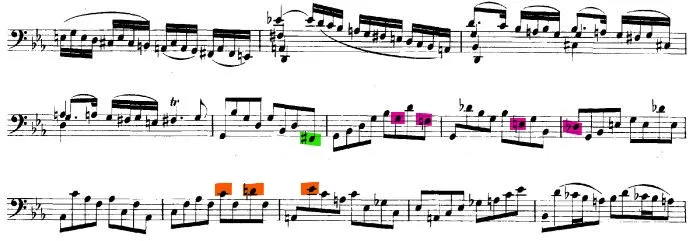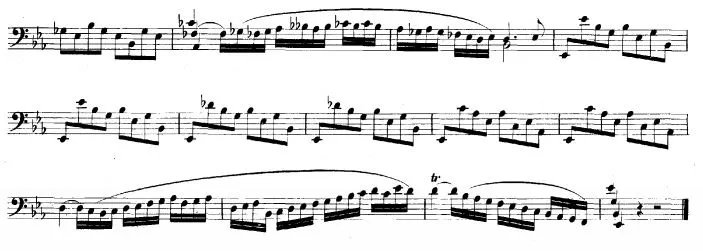Bach Suite 4, Prelude
Abstract
One of the key technical challenges to the 4th Suite is maintaining a base of intonation that revolves around the introduced chords. It is extremely easy to lose the base pitch and to waver in intonation especially in the prelude of this suite. Another technical challenge is to maintain a loose bow-hand that carries weight, drawing a clear contact point with the string regardless of the delicacy or forwardness of the note itself. The falling arpeggios of the prelude tend to often end up being extremely monotonous and its up to the player to find a tempo and bow stroke that negates that feeling.
There are many ways to interpret Bach and many scholars and musicians will have extremely long and quite frankly, tiresome arguments on the interpretations of his music. I personally think as long as its convincing, you can do whatever the hell you want with his music. Isn't that the beauty behind music anyways? I hear this prelude as the thoughts of an individual as he progresses through a certain stage of his life.
Opening Statement
I see the opening phrase as a two voice reflection, with the second voice (Blue highlight) restating the first voice in a softer subtler undertone. The Eb (Red highlight) is restated every bar and is always present as a pedal tone, I focused primarily on bringing out the Eb every two bars because it never really leaves the ear. A continuous presence that creates a base that the moving harmonies can always return to. There is a lot of confidence in this passage, young and unabashed, nothing stands in the way of his statement.

C minor
After the initial statement, it modulates to c minor with a restatement of the Eb pedal tone (blue highlight) in the upper register. Disregarding the more academic approach, I hear that Eb as rather doleful. Reflecting upon an earlier time where it still had youth and exuberance. The A natural (red highlight) cements the modulation and then leaves a question hanging with the upper A (orange highlight). This passage begins the journey of searching for an answer after the initial exclamatory opening.

A Burst of Confidence
Oftentimes in life we find ourselves questioning our ideologies, our path, and most often our purpose. We grapple aimlessly with society and ourselves, searching for a higher sense of reasoning that can explain the pain, joy, serenity, beauty, and helplessness of life. But every now and then there is a burst of inspiration given by a unique source that pushes you to achieve a higher point. This phrase right here, represents that burst of inspiration.

Coming out of a seemingly endless tunnel of winding arpeggios, it begins its climb led by a series of restated notes in the upper voice. Building with energy with each passing note it gives off the aura of achievement.
Doubt
After such an exalted and exuberant phrase, doubt begins to claw at the back of the mind. A small question of "Is it still possible for you to achieve anything worthwhile in your life" (Blue highlight) flutters around and with diminishing confidence it is answered "Yes, I still have it."(Red highlight). There is another climb (Orange highlight), another burst of energy that seems to dissipate as quickly as it was conjured. Losing direction with every passing note, it slowly falls away into emptiness.

Aimless Wandering
As if lost in thought, the sixteen notes spin in every direction with a sort of improvisatory feel to it. It is followed with a set of two falling arpeggios that no longer have confidence nor commitment. There is a sense of wallowing in one's despair but yet despite all that, there is a touch of tenderness. A tendril of hope that there is still a possibility of success at the end of this road.

Anger and Regret
The line of thought slowly builds into a cascade of emotions, embarking on a journey of self-justification, it explodes into anger which are represented by the chords. The energy of the outburst slowly fades away on the trilled F# before it flows into a passage of regret and resurgence. A subtly hidden motive treads downwards (Red highlight), a nod to the self doubt that is still there at the back of the mind but it is quickly followed by an attempt of redemption (Orange highlight). There is a feeling of intimacy in this passage and a sense of profoundness found in the onslaught of emotions.

Conclusion
After a series of reflections, ideas, and attempts, it returns back to the main theme. It returns with even more power and conviction than the opening. Empowered by past experiences and struggles, it no longer contains any reminisce of doubt. The final sixteen note runs are a reflection of the gained maturity and reflects upon the lessons learned from the darkest point of past experiences.

